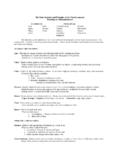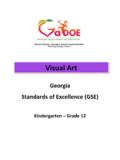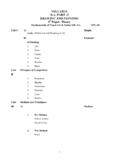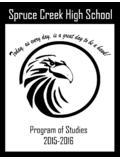Transcription of G CONTENT RADE LEVEL K EXPECTATIONS - michigan.gov
1 K I N D E R GA RT E N E N G L I S H L A N G U A G E A R T S. GRADE LEVEL . K. ELA. CONTENT . EXPECTATIONS Welcome to michigan 's K-8 Grade LEVEL CONTENT EXPECTATIONS R EA D I N G. Purpose & Overview In 2004, the michigan Department of Education embraced the challenge of creating Grade LEVEL CONTENT EXPECTATIONS in response to the federal No Child Left Behind Act W R IT I N G. of 2001. This act mandated the existence of a set of comprehensive state grade LEVEL assessments that are designed based on rigorous grade LEVEL CONTENT . In this global economy, it is essential that michigan students possess personal, social, S P EA K I N G occupational, civic, and quantitative literacy. Mastery of the knowledge and essential skills de ned in michigan 's Grade LEVEL CONTENT EXPECTATIONS will increase students' ability to be successful academically, contribute to the future businesses that employ them and the communities in which they choose to live.
2 L I ST E N I N G. The Grade LEVEL CONTENT EXPECTATIONS build from the michigan Curriculum Framework and its Teaching and Assessment Standards. Re ecting best practices and current research, they provide a set of clear and rigorous EXPECTATIONS for all students and V I EW I N G provide teachers with clearly de ned statements of what students should know and be able to do as they progress through school. Why Create a Version of the EXPECTATIONS ? The Of ce of School Improvement is committed to creating the best possible product for educators. This commitment served as the impetus for the revision of the edition that was previously released in June of 2004. This new version, , re nes and clari es the original EXPECTATIONS , while preserving their essence and original intent.
3 As education continues to evolve, it is important to remember that each curriculum document should be considered as a work in progress, and will continue to be re ned to improve the quality. The revision process greatly improved the continuity from one grade to the next, and better ensured coherence both in CONTENT and pedagogy. To obtain more speci c details about the revisions, please refer to the addendum included in this document. The forward of the Across the Grades companion document also clari es the types of changes made. Educators can access the Across the Grades companion document by visiting the michigan Department of Education Grade LEVEL CONTENT EXPECTATIONS web page at Assessment The Grade LEVEL CONTENT EXPECTATIONS document is intended to be a state assessment tool with the EXPECTATIONS written to convey expected performances by students.
4 The Of ce of Assessment and Accountability was involved in the development of version and has incorporated the changes in the construction of test and item speci cations for the K-8 michigan Education Assessment Program (MEAP) and MI-Access. This updated version will assist us in the creation of companion documents, CONTENT Of ce of School Improvement examples, and to guide program planners in focusing resources and energy. Curriculum Using this document as a focal point in the school improvement process, schools and districts can generate conversations among stakeholders concerning current policies and practices to consider ways to improve and enhance student achievement. Together, stakeholders can use these EXPECTATIONS to guide curricular and instructional decisions, identify professional development needs, and assess student achievement.
5 Understanding the Organizational Structure The EXPECTATIONS in this document are divided into strands with multiple domains within each, as shown below. The skills and CONTENT addressed in these EXPECTATIONS will in practice be woven together into a coherent, English language arts curriculum. Beyond the English language arts curriculum, students will use the skills and processes to support learning in all CONTENT areas. To allow for ease in referencing EXPECTATIONS , each expectation has been coded with a strand, domain, grade- LEVEL , and expectation number. For example, indicates: R - Reading Strand NT - Narrative Text Domain 00 - Kindergarten Expectation 01- First Expectation in the Grade- LEVEL Narrative Text Domain Strand 1 Strand 2 Strand 3 Strand 4.
6 Reading Writing Speaking Listening & Viewing Domains Word Recognition and Genre (GN) Conventions (CN) Conventions (CN). Word Study (WS) Process (PR) Discourse (DS) Response (RP). Phonemic Awareness Personal Style (PS). Phonics Grammar & Usage (GR). Word Recognition Spelling (SP). Vocabulary Handwriting (HW). Fluency (FL) Writing Attitude (AT). Narrative Text (NT). Informational Text (IT). Comprehension (CM). Metacognition (MT). Critical Standards (CS). Reading Attitude (AT). Preparing Students for Academic Success Within the hands of teachers, the Grade LEVEL CONTENT EXPECTATIONS are converted into exciting and engaging learning for michigan 's students. As we use these EXPECTATIONS to develop units of instruction and plan instructional delivery, it is critical to keep in mind that CONTENT knowledge alone is not suf cient for academic success.
7 Students must be able to apply knowledge in new situations, to solve problems by generating new ideas, and to make connections between what they learn in class to the world around them. The art of teaching is what makes the CONTENT of learning become a reality. Through the collaborative efforts of michigan educators and creation of professional learning communities, we can enable our young people to attain the highest standards, and thereby open doors for them to have ful lling and successful lives. 2 K I N D E R G A RT E N E N G L I S H L A N G U A G E A RT S 2 . 0 5 michigan DEPARTMENT OF EDUCATION. READING Word Recognition and Word Study Phonemic Awareness Students will . demonstrate phonemic awareness by the wide range of sound manipulation competencies including sound blending and deletion.
8 Recognize that words are composed of sounds blended together and carry meaning. Phonics Students will . understand the alphabetic principle, that sounds in words are expressed by the letters of the alphabet. use grapho-phonemic (letter-sound) cues to recognize a few one-syllable words when presented completely out of context. Begin to associate letters and sounds, particularly initial and nal consonants. Word Recognition Students will . automatically recognize a small number (about 18) of frequently encountered, personally meaningful words in print. make progress in automatically recognizing a few of the 220 Dolch basic sight words. follow familiar written text while pointing to matching words. narrow possibilities in predicting words using initial letters/sounds (phonics), patterns of language (syntactic), and picture clues (semantic).
9 Know the meanings of words encountered frequently in grade- LEVEL reading and oral language contexts. Vocabulary Students will . in context, determine the meaning of a few words, familiar and repeated phrases including objects, actions, concepts, CONTENT vocabulary, and literary terms, using strategies and resources including picture clues, prediction, and other people. Fluency Students will . automatically apply the following aspects of uency: naming of letters, association of letters and their sounds, recognition of a few words both when encountered in context and isolation, and demonstrating understanding of concepts of print. M I C H I G A N D E PA RT M E N T O F E D U C AT I O N 2 . 0 5 E N G L I S H L A N G U A G E A RT S K I N D E R G A RT E N 3.
10 Narrative Text Students will . become familiar with classic, multicultural, and contemporary literature recognized for quality and literary merit that represents our common heritage as well as cultures from around the world. identify the basic form and purpose of a variety of narrative genre including stories, nursery rhymes, poetry, and songs. discuss setting, characters, and events in narrative text. identify how authors/illustrators use literary devices including pictures and illustrations to support the understanding of settings and characters. respond to individual and multiple texts by nding evidence, discussing, illustrating, and/or writing to re ect, make meaning, and make connections. Informational Text Students will.














